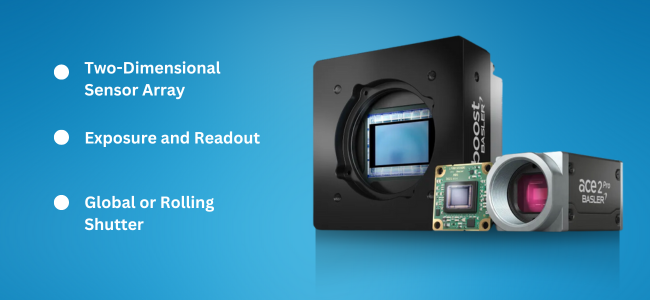What is an Area Scan Camera?
Published on: Sep 04, 2024

Written by: Admin
What is an Area Scan Camera?
An area scan camera is a type of digital camera that captures images using a two-dimensional array of pixels, allowing it to capture an entire image at once. This contrasts with line scan cameras, which capture images one line at a time. Area scan cameras are widely used in various applications due to their versatility and ability to capture detailed, high-resolution images.

How Area Scan Cameras Work
- Two-Dimensional Sensor Array:
- Area scan cameras use a sensor with a two-dimensional array of pixels, allowing the entire image to be captured simultaneously.
- Exposure and Readout:
- During exposure, light from the scene hits the sensor, and each pixel accumulates charge proportional to the light intensity.
- After exposure, the sensor readout converts the accumulated charge in each pixel to a digital signal, creating the image.
- Global or Rolling Shutter:
- Area scan cameras can use either global shutters, which expose all pixels simultaneously, or rolling shutters, which expose rows of pixels sequentially.

Applications of Area Scan Cameras
Area scan cameras are suitable for a wide range of applications due to their ability to capture entire scenes in a single frame. Some common use cases include:
- General Photography and Videography:
- Use Case: Capturing still images or video footage.
- Advantage: Versatile and capable of capturing detailed, high-resolution images.
- Surveillance:
- Use Case: Monitoring large areas for security purposes.
- Advantage: Ability to capture wide scenes and detailed images.
- Microscopy:
- Use Case: Imaging biological samples or materials at high magnification.
- Advantage: High-resolution imaging with detailed information.
- Industrial Inspection:
- Use Case: Inspecting products on production lines for defects or quality control.
- Advantage: Capturing detailed images of stationary or slow-moving objects.
- Medical Imaging:
- Use Case: Capturing detailed images for diagnostic purposes.
- Advantage: High-resolution imaging of tissues or organs.
When to Use Line Scan Cameras Over Global Shutter Cameras
Line scan cameras are preferred over global shutter cameras in specific scenarios where continuous and high-resolution imaging of moving objects or large surfaces is required. Here are some situations where line scan cameras are advantageous:
- Continuous Web Inspection:
- Use Case: Inspecting continuous materials like paper, textiles, or metal sheets during production.
- Advantage: Line scan cameras can capture high-resolution images of continuous surfaces without gaps or distortions, providing uniform illumination and detailed inspection.
- Large Object Scanning:
- Use Case: Imaging large objects or surfaces, such as aircraft wings, vehicle bodies, or ship hulls.
- Advantage: Line scan cameras can scan large areas with high resolution, ensuring detailed and accurate imaging.
- High-Speed Conveyor Systems:
- Use Case: Inspecting products moving at high speeds on conveyor belts.
- Advantage: Line scan cameras can capture clear and detailed images of fast-moving objects without motion blur, unlike area scan cameras with rolling shutters.
- Print Inspection:
- Use Case: Checking the quality of printed materials like newspapers, magazines, and labels.
- Advantage: Line scan cameras provide high-resolution images of printed materials, ensuring detailed inspection and defect detection.
- Document Scanning:
- Use Case: Digitizing large-format documents, books, or artworks
- Advantage: Line scan cameras can scan large documents with high resolution and consistency, ensuring accurate reproduction.
Area scan cameras are versatile and widely used for capturing detailed, high-resolution images in a variety of applications. However, line scan cameras are preferred over global shutter cameras in scenarios requiring continuous and high-resolution imaging of moving objects or large surfaces, such as continuous web inspection, large object scanning, high-speed conveyor systems, print inspection, and document scanning. When choosing between these camera types, consider the specific requirements of your application, including the need for high-speed motion capture, resolution, and the nature of the objects or surfaces being imaged.

